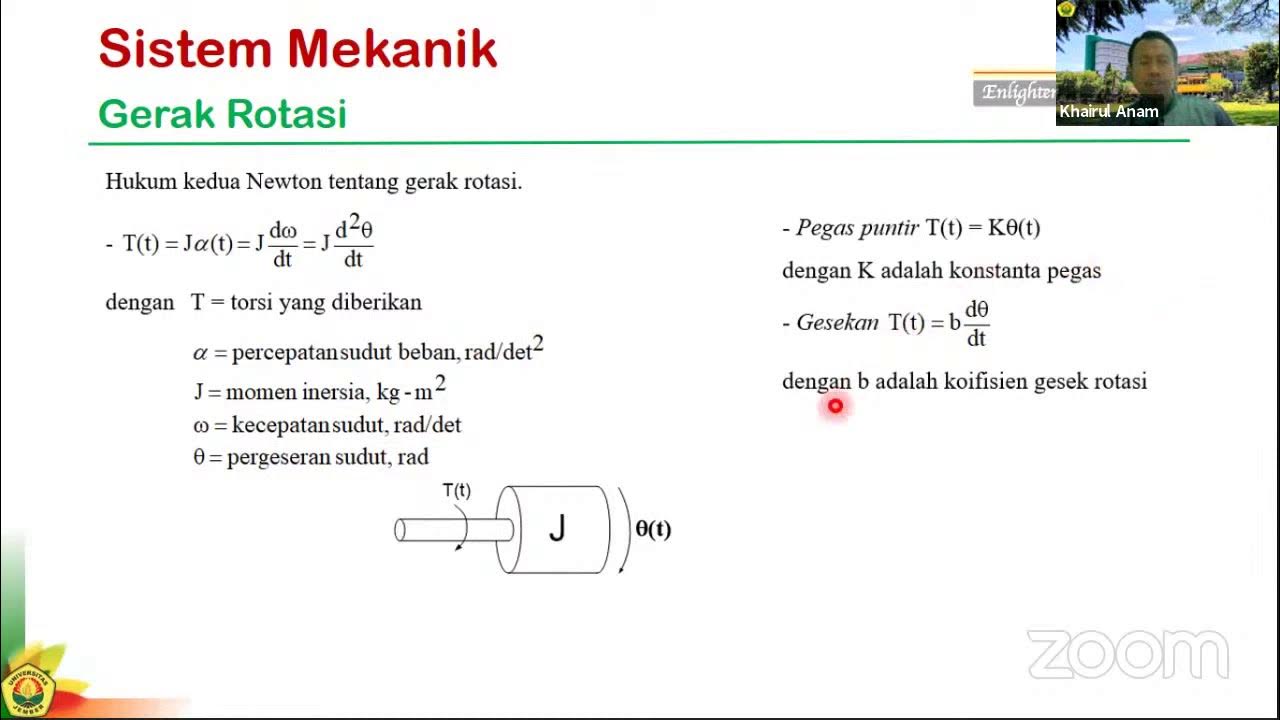Modern Robotics, Chapter 13.2: Omnidirectional Wheeled Mobile Robots (Part 2 of 2)
Summary
TLDRThis video explains the kinematic modeling and motion control of omnidirectional wheeled robots. It covers how the chassis configuration, including heading direction and position, is related to wheel speeds. The script discusses trajectory planning, feedback control (using feedforward plus PI control), and state estimation using odometry or external sensors. It highlights the importance of bounded wheel speeds in motion planning, describing how constraints on wheel speeds define feasible robot velocities in a polyhedral twist space. For omnidirectional robots with 3 wheels, feasible velocities form a hexagonal region, while for 4-wheeled robots, they form a square.
Takeaways
- 😀 Omnidirectional robots can achieve any desired velocity through a proper selection of wheel speeds.
- 😀 The configuration of a wheeled robot is represented by the vector q = (phi, x, y), which includes the robot's heading and position.
- 😀 Motion planning and control for omnidirectional robots are relatively simple due to the direct relationship between wheel speeds and robot velocity.
- 😀 Kinematic trajectory generation methods from Chapter 9 and motion planners from Chapter 10 can be directly applied to omnidirectional robots.
- 😀 Control of omnidirectional robots involves a combination of feedforward control and PI (Proportional-Integral) feedback to minimize errors in the robot's motion.
- 😀 Chassis velocity is calculated as the sum of the desired velocity and feedback terms, which account for configuration errors and their integral over time.
- 😀 Estimating the chassis configuration (q) can be done through odometry or external sensors like cameras, GPS, or laser range finders.
- 😀 Once the desired chassis velocity (q-dot) is calculated, wheel speeds are determined using the robot's kinematic model.
- 😀 Wheel speed bounds are considered during motion planning to ensure feasible robot movements and prevent exceeding wheel limitations.
- 😀 The feasible velocities of the robot, constrained by wheel speed limits, form a polyhedron. For three wheels, the feasible velocities are bounded by a hexagon, and for four mecanum wheels, the bounds form a square.
Q & A
What is the configuration of the chassis of a wheeled robot?
-The configuration of the chassis of a wheeled robot can be represented as q = (phi, x, y), where phi is the heading direction and x, y are the position coordinates of the chassis.
What is the relationship between wheel speeds and chassis velocity in an omnidirectional robot?
-The relationship between wheel speeds and chassis velocity is given by the equation u = H(phi) * q-dot, where u is the vector of wheel speeds, H(phi) is a transformation matrix, and q-dot is the velocity of the chassis.
Why is motion planning and control relatively simple for omnidirectional robots?
-Motion planning and control of omnidirectional robots is relatively simple because any desired chassis velocity (q-dot) can be achieved by properly selecting the wheel speeds, which provides greater flexibility in maneuverability.
What methods from Chapters 9 and 10 can be applied directly to omnidirectional robots?
-All the kinematic trajectory generation methods from Chapter 9 and most of the motion planners from Chapter 10 can be directly applied to omnidirectional robots.
How is the commanded chassis velocity q-dot calculated in motion control?
-The commanded chassis velocity q-dot is calculated as the sum of the desired chassis velocity at the current time plus feedback terms, which include the proportional error and the integral of the error over time.
What type of controller is described for omnidirectional robots, and what does it provide?
-The controller described is a feedforward plus PI feedback control, which provides reasonable performance by adjusting the robot's velocity based on both current errors and accumulated errors over time.
How is the chassis configuration q estimated in motion control systems?
-The chassis configuration q can be estimated using odometry, or external sensors such as cameras, GPS, or laser range finders.
What should motion planners consider when calculating wheel speeds for a robot?
-Motion planners must consider the bounded speeds of the wheels when calculating wheel speeds to ensure that they do not exceed the maximum allowed velocities for each wheel.
What does the kinematic model's twist space represent in relation to wheel speed bounds?
-In the kinematic model, bounds on the wheel speeds translate to bounds on the chassis twist in the body frame. These bounds create two parallel planes in the twist space that define the feasible region for the robot's motion.
What geometric shape defines the feasible linear velocities for an omnidirectional robot?
-For an omnidirectional robot with 3 wheels, the feasible linear velocities are defined by a hexagon in the plane of zero angular velocity.
How does the feasible twist space differ between omnidirectional robots with 3 and 4 wheels?
-For a robot with 3 omniwheels, the feasible twist space is a 6-sided polyhedron. For a robot with 4 mecanum wheels, the feasible twist space is an 8-sided polyhedron, and the feasible linear velocities form a square in the plane of zero angular velocity.
Outlines

Esta sección está disponible solo para usuarios con suscripción. Por favor, mejora tu plan para acceder a esta parte.
Mejorar ahoraMindmap

Esta sección está disponible solo para usuarios con suscripción. Por favor, mejora tu plan para acceder a esta parte.
Mejorar ahoraKeywords

Esta sección está disponible solo para usuarios con suscripción. Por favor, mejora tu plan para acceder a esta parte.
Mejorar ahoraHighlights

Esta sección está disponible solo para usuarios con suscripción. Por favor, mejora tu plan para acceder a esta parte.
Mejorar ahoraTranscripts

Esta sección está disponible solo para usuarios con suscripción. Por favor, mejora tu plan para acceder a esta parte.
Mejorar ahoraVer Más Videos Relacionados

Modern Robotics, Chapter 13.2: Omnidirectional Wheeled Mobile Robots (Part 1 of 2)

mod01lec03 - Introduction to Mobile Robot Kinematics

SK#2c: Pemodelan Sistem dengan Persamaan Differensial

Robot Kinematics Foundations | Robotic Systems

How To Solve Projectile Motion Problems In Physics

8.2. Rotational Kinematics
5.0 / 5 (0 votes)
